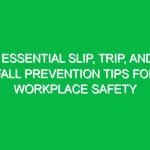Introduction
Confined spaces are areas that are not designed for continuous human occupancy and can pose significant health and safety risks. In the Health, Safety, and Environment (HSE) domain, understanding the intricacies of confined space safety is of paramount importance. These spaces can include tanks, vessels, silos, pits, tunnels, and pipelines, where hazards may not be immediately evident. This guide aims to provide a comprehensive exploration of confined space safety, emphasizing the critical practices and regulations necessary to protect lives today.
Understanding Confined Spaces
To navigate the complexities of confined space safety, it is essential to define what constitutes a confined space. According to the Occupational Safety and Health Administration (OSHA), a confined space is defined by three criteria: it must be large enough to enter and work, it must not be designed for continuous occupancy, and it must have limited means of entry or exit. These factors contribute to the unique hazards associated with confined spaces, making it vital for organizations to implement strict safety protocols.
Key Hazards in Confined Spaces
The risks associated with confined spaces can be severe and multifaceted. Here are some of the primary hazards:
- Atmospheric Hazards: These include oxygen deficiency, toxic gases, flammable vapors, and hazardous dust. For instance, in a sewage treatment plant, the accumulation of methane can create an explosive atmosphere.
- Physical Hazards: These encompass risks related to machinery, engulfment, and falls. Workers in a storage tank may be at risk of being engulfed if the material inside shifts unexpectedly.
- Biological Hazards: In some cases, confined spaces can harbor pathogens, such as bacteria or viruses, especially in environments like wastewater treatment facilities.
- Limited Mobility: The restricted space can hinder escape, making it challenging for workers to react quickly in emergencies.
Real-Life Example: The Tragedy at the Kansas City Water Treatment Plant
In 2016, a tragic incident at a Kansas City water treatment plant highlighted the potential dangers of confined spaces. Workers were tasked with cleaning a large tank when one employee collapsed due to a lack of oxygen. Two others attempted to rescue him but were also overcome by the hazardous atmosphere. This incident resulted in three fatalities and served as a stark reminder of the importance of adhering to safety protocols in confined spaces.
Best Practices for Confined Space Safety
Implementing best practices for confined space safety can significantly reduce risks and protect workers. Here are some actionable guidelines:
1. Conduct Thorough Risk Assessments
Before any work begins in a confined space, a comprehensive risk assessment should be conducted. This assessment should identify potential hazards, evaluate the risks, and determine necessary control measures. Engaging workers in this process can also provide valuable insights into potential dangers.
2. Implement a Permit System
A permit-to-work system is essential for managing confined space activities. This system should outline the specific responsibilities of all personnel involved, the procedures to be followed, and the safety measures that must be in place. It ensures that all parties are aware of the risks and the protocols necessary to mitigate them.
3. Provide Adequate Training
Training is pivotal in ensuring that workers are equipped to handle the unique challenges of confined spaces. Training should cover hazard recognition, emergency response procedures, and the proper use of personal protective equipment (PPE). Regular refresher courses can help maintain awareness and preparedness.
4. Utilize Proper Ventilation
Ventilation is crucial in confined spaces to maintain safe atmospheric conditions. Continuous monitoring of air quality can help ensure that oxygen levels are adequate and that harmful gases are kept at bay. Mechanical ventilation systems can be employed to circulate fresh air into the space.
5. Ensure Effective Communication
Establishing robust communication protocols is essential in confined space work. All team members should be equipped with communication devices, such as radios, to maintain contact during operations. Additionally, a designated safety officer should oversee the operation and be prepared to respond to emergencies.
Regulations and Standards Governing Confined Space Safety
In the HSE domain, several regulations and standards govern confined space safety. Compliance with these guidelines is crucial for organizations to ensure worker safety and avoid legal ramifications.
1. OSHA Standards
OSHA has established specific standards for confined spaces in general industry (29 CFR 1910.146). These standards require employers to evaluate their workplaces, develop written procedures, and provide appropriate training and equipment for employees working in confined spaces.
2. National Fire Protection Association (NFPA)
The NFPA provides guidelines that address the risks of confined spaces in relation to fire hazards. Compliance with NFPA standards can help organizations implement effective fire prevention measures in confined spaces.
3. American National Standards Institute (ANSI)
ANSI has developed standards that cover various aspects of confined space safety, including entry procedures, rescue plans, and the use of personal protective equipment. Adhering to ANSI standards can enhance overall safety practices in confined spaces.
4. Local Regulations
In addition to federal standards, organizations must also be aware of state and local regulations that may impose additional requirements for confined space safety. Regularly reviewing and updating safety protocols in accordance with these regulations is essential for compliance.
Emergency Procedures for Confined Spaces
Despite the best safety measures, emergencies can still occur in confined spaces. Having a well-defined emergency response plan is critical. This plan should include:
- Rescue Procedures: Develop clear procedures for rescuing individuals in confined spaces. This should include training for a designated rescue team and ensuring they have the necessary equipment to carry out rescues safely.
- Emergency Equipment: Ensure that emergency equipment, such as first aid kits, rescue harnesses, and breathing apparatus, is readily available and inspected regularly.
- Regular Drills: Conduct regular emergency drills to prepare workers for potential incidents. These drills should simulate various scenarios to test the effectiveness of the response plan.
Conclusion
Understanding confined space safety is critical in promoting health, safety, and environmental sustainability within the workplace. By recognizing the unique hazards associated with confined spaces and implementing best practices, organizations can significantly reduce the risks to their workers. Compliance with established regulations and continuous training are essential components of an effective confined space safety program. Protecting lives today requires a commitment to safety and the shared responsibility of all workers and employers. As we move forward, let us prioritize confined space safety to ensure that no tragic incidents occur due to negligence or oversight. Together, we can create a safer working environment for all.


